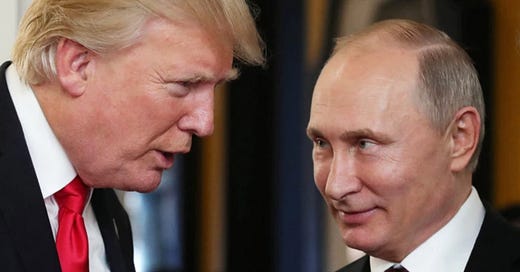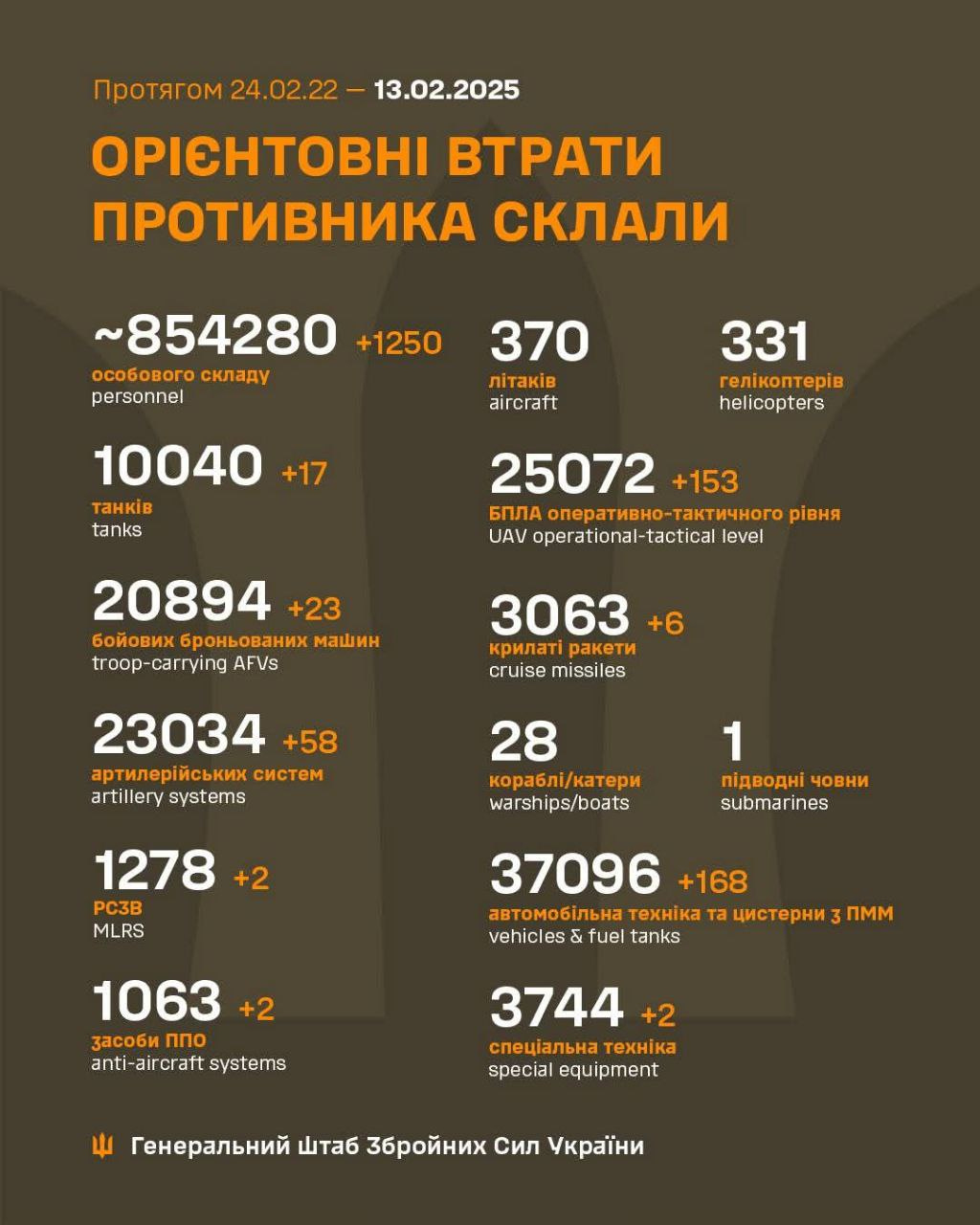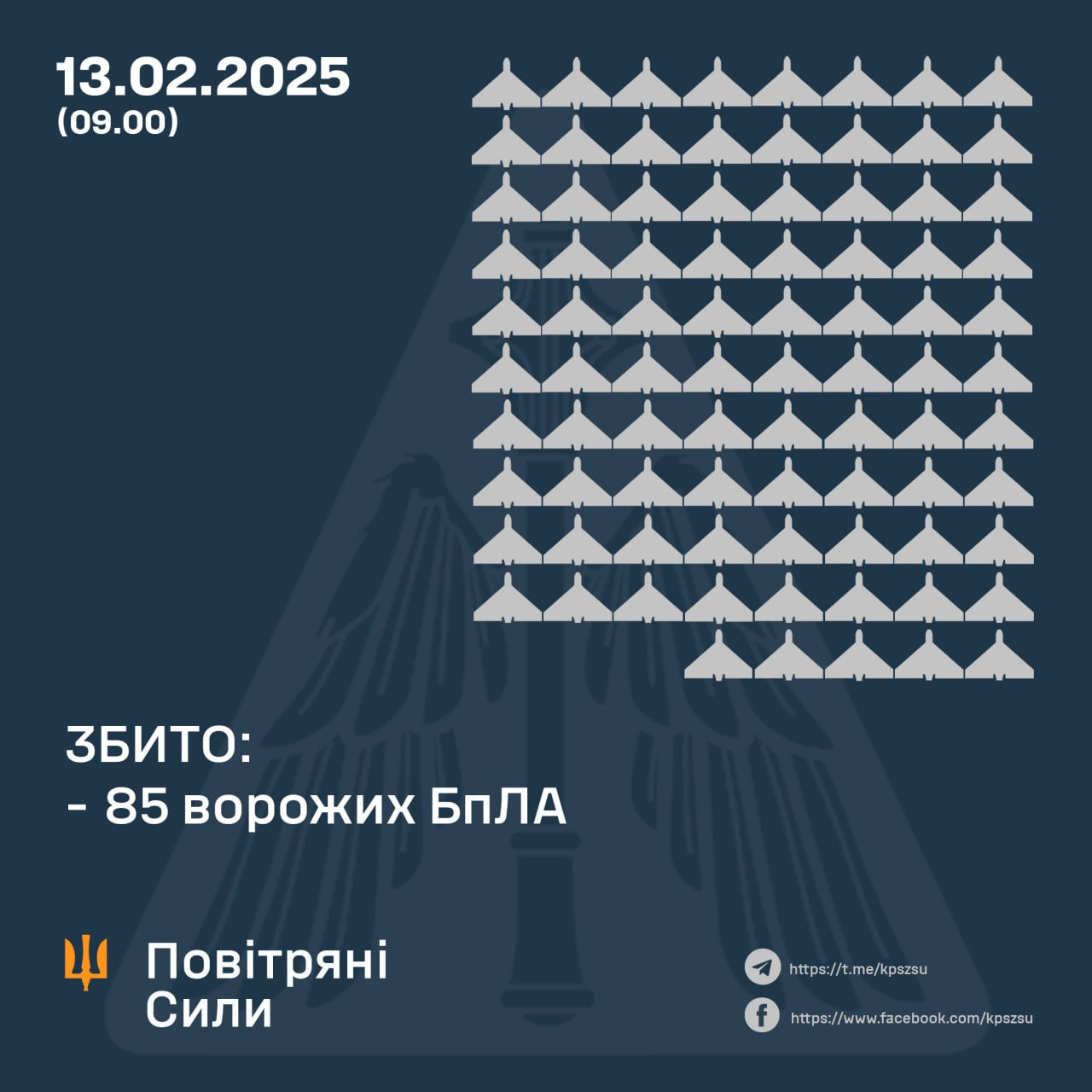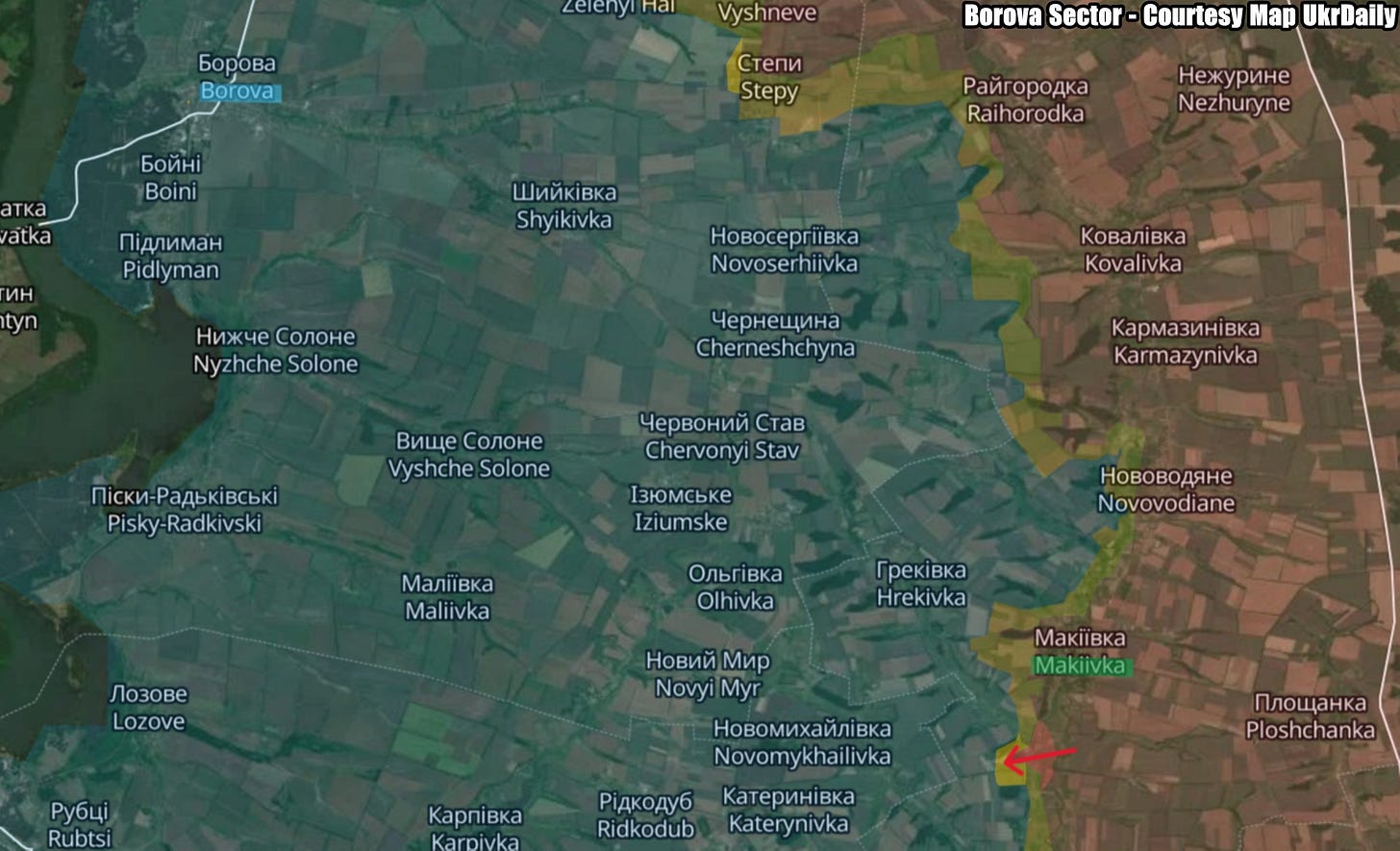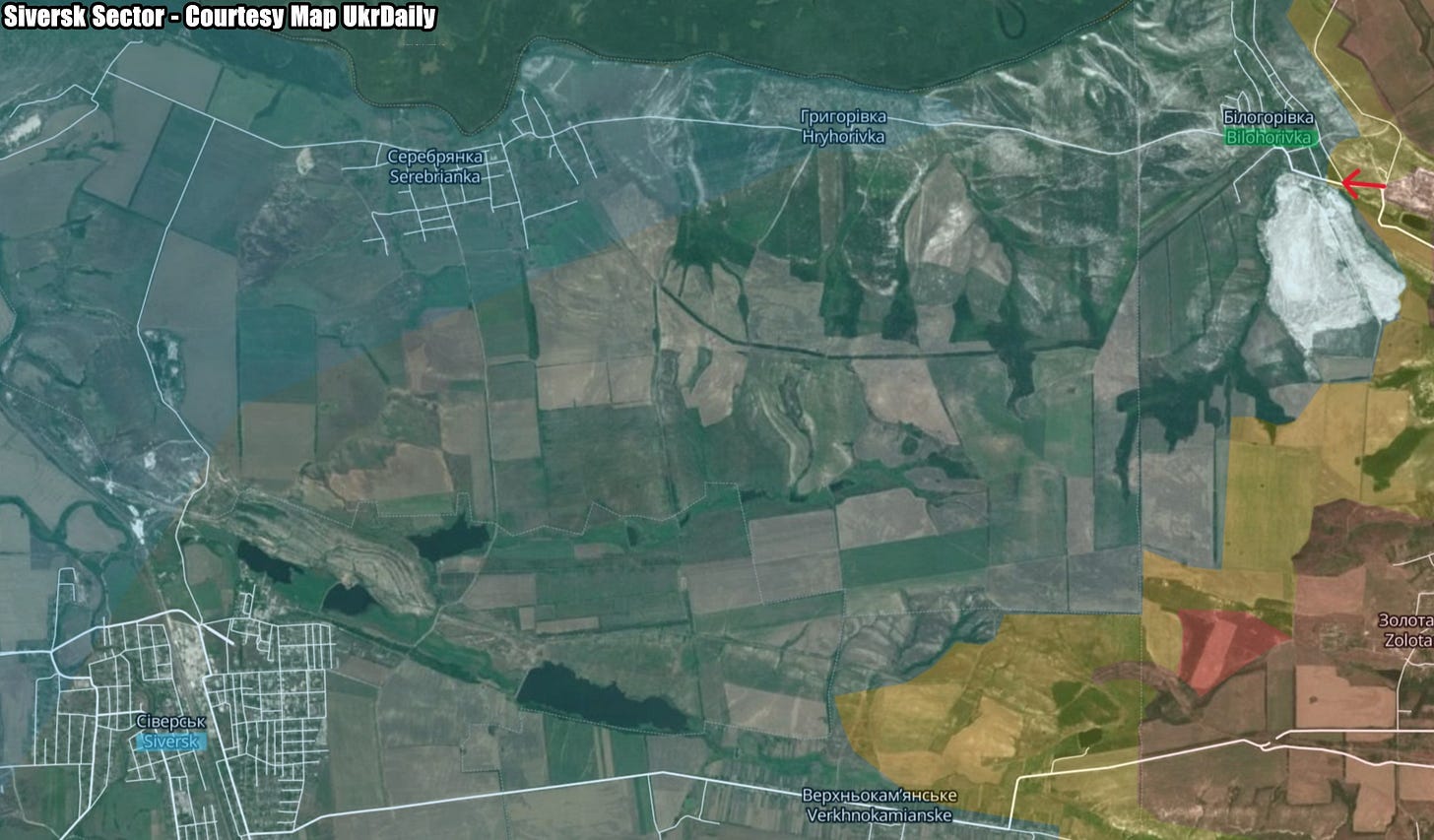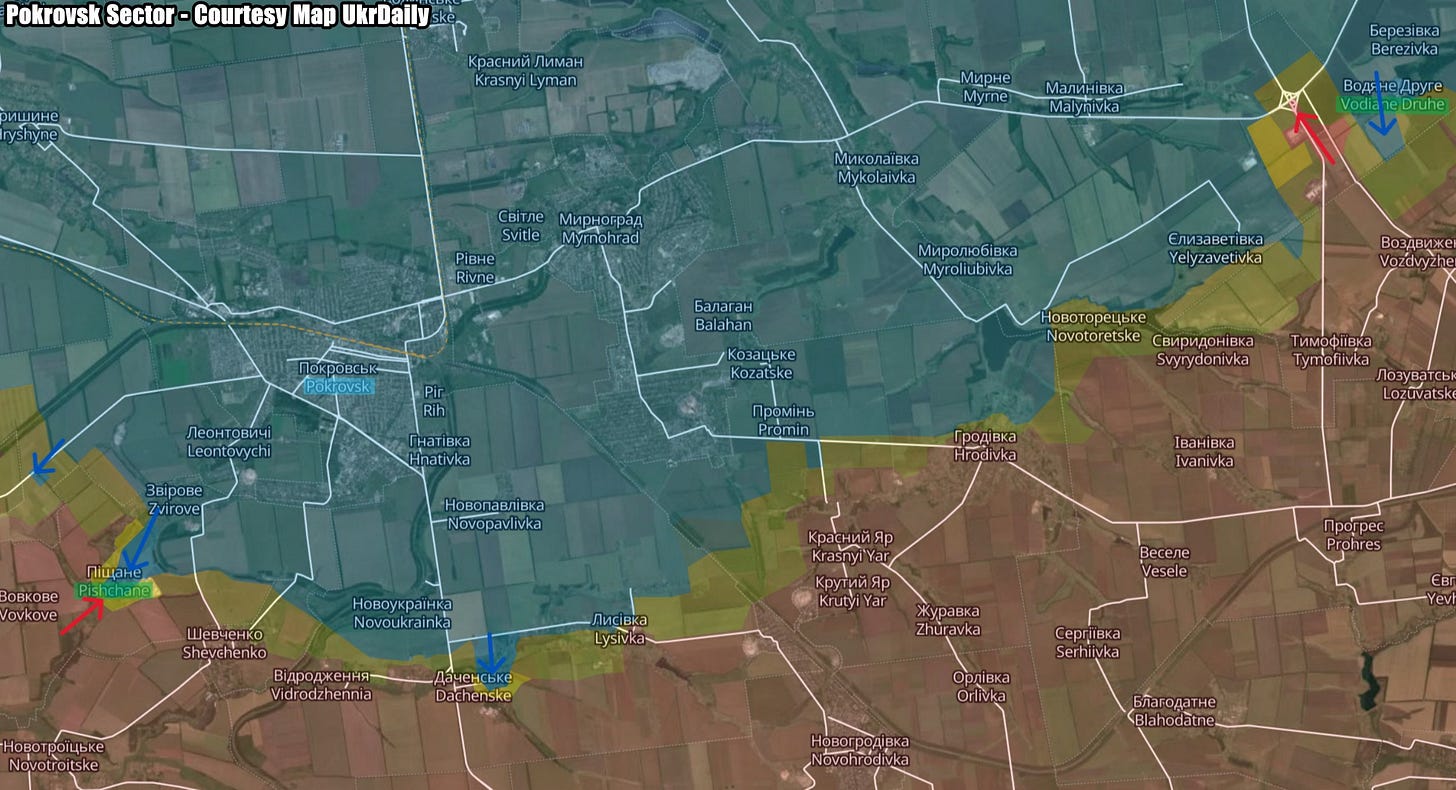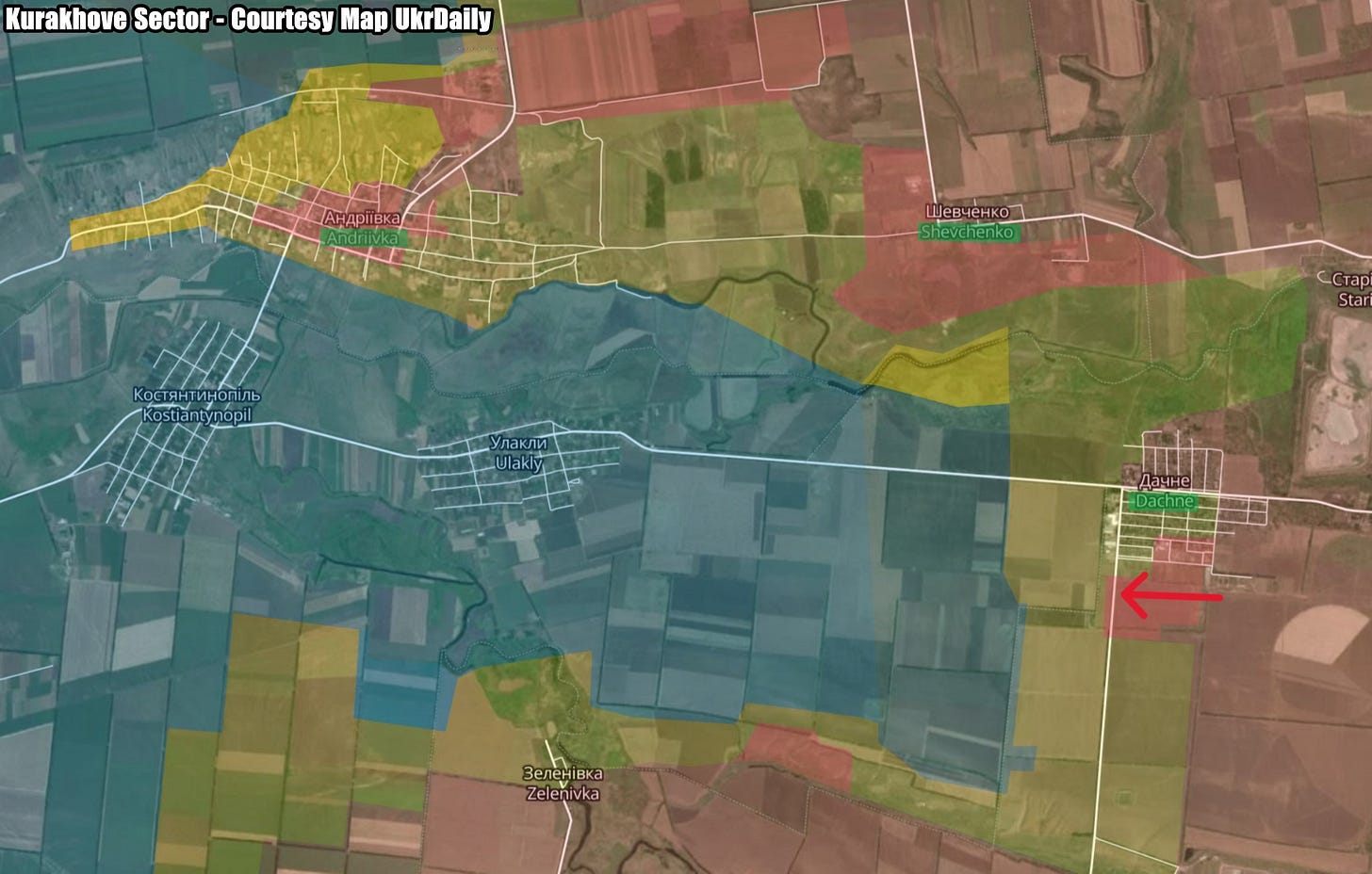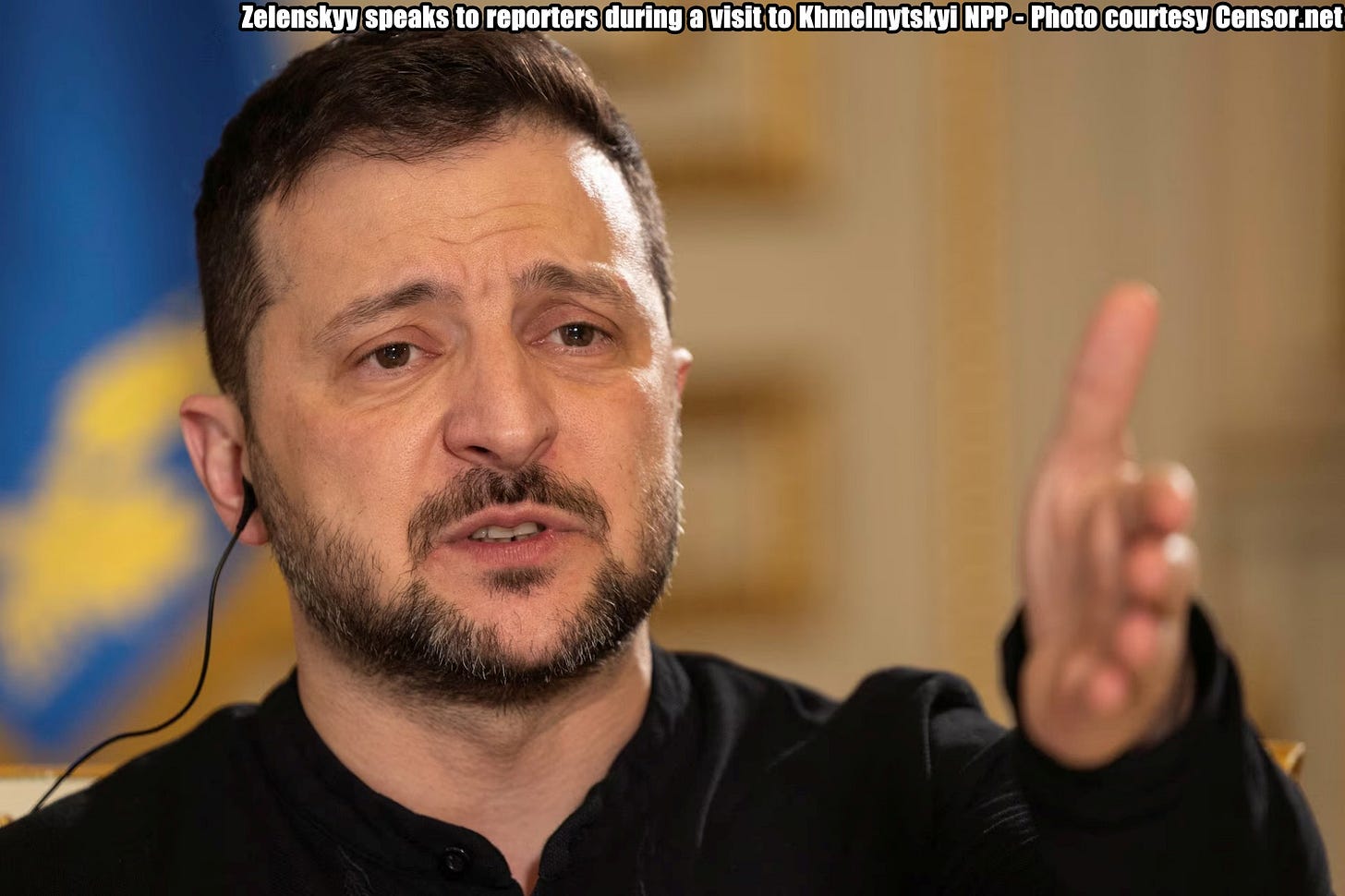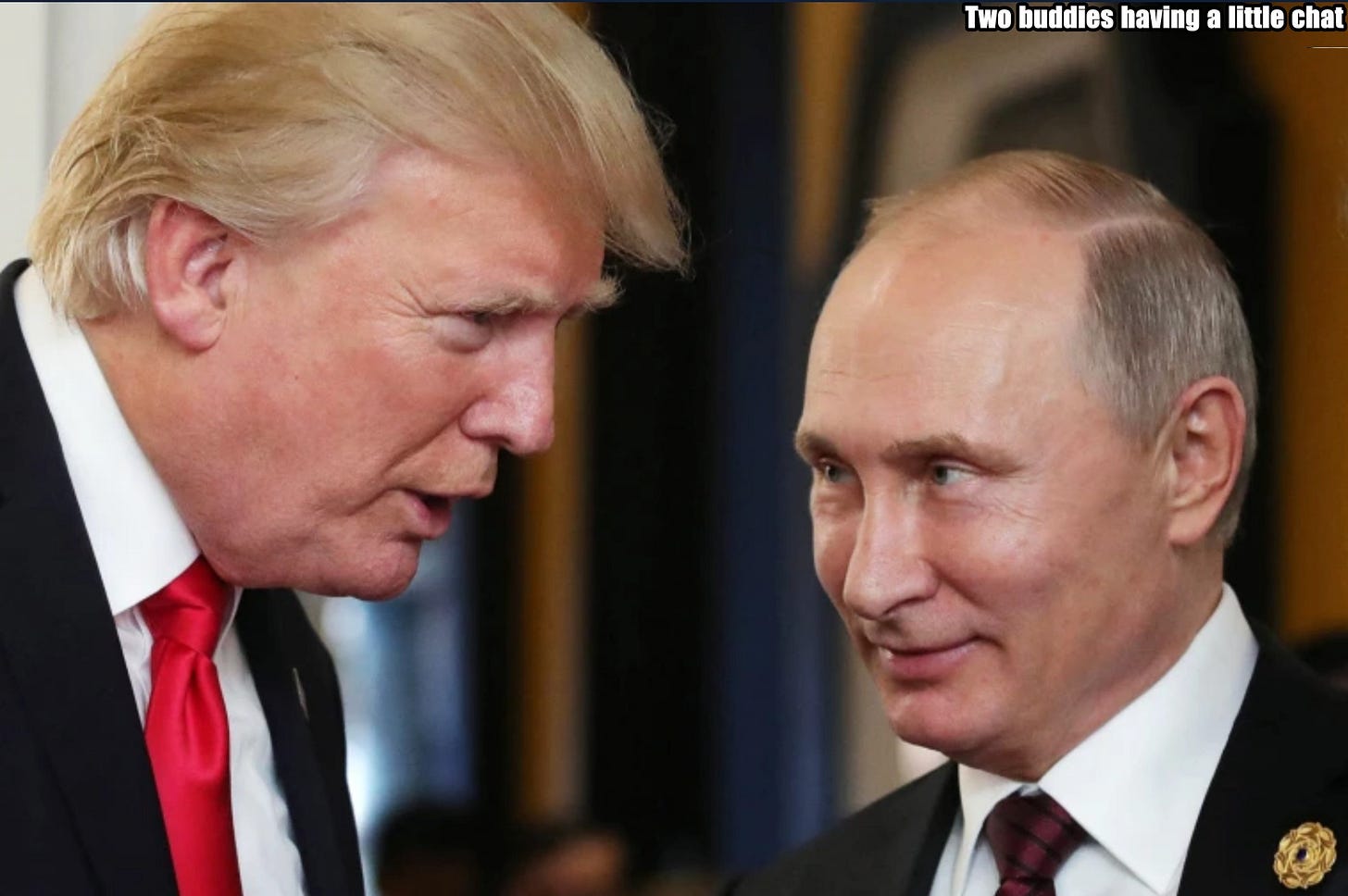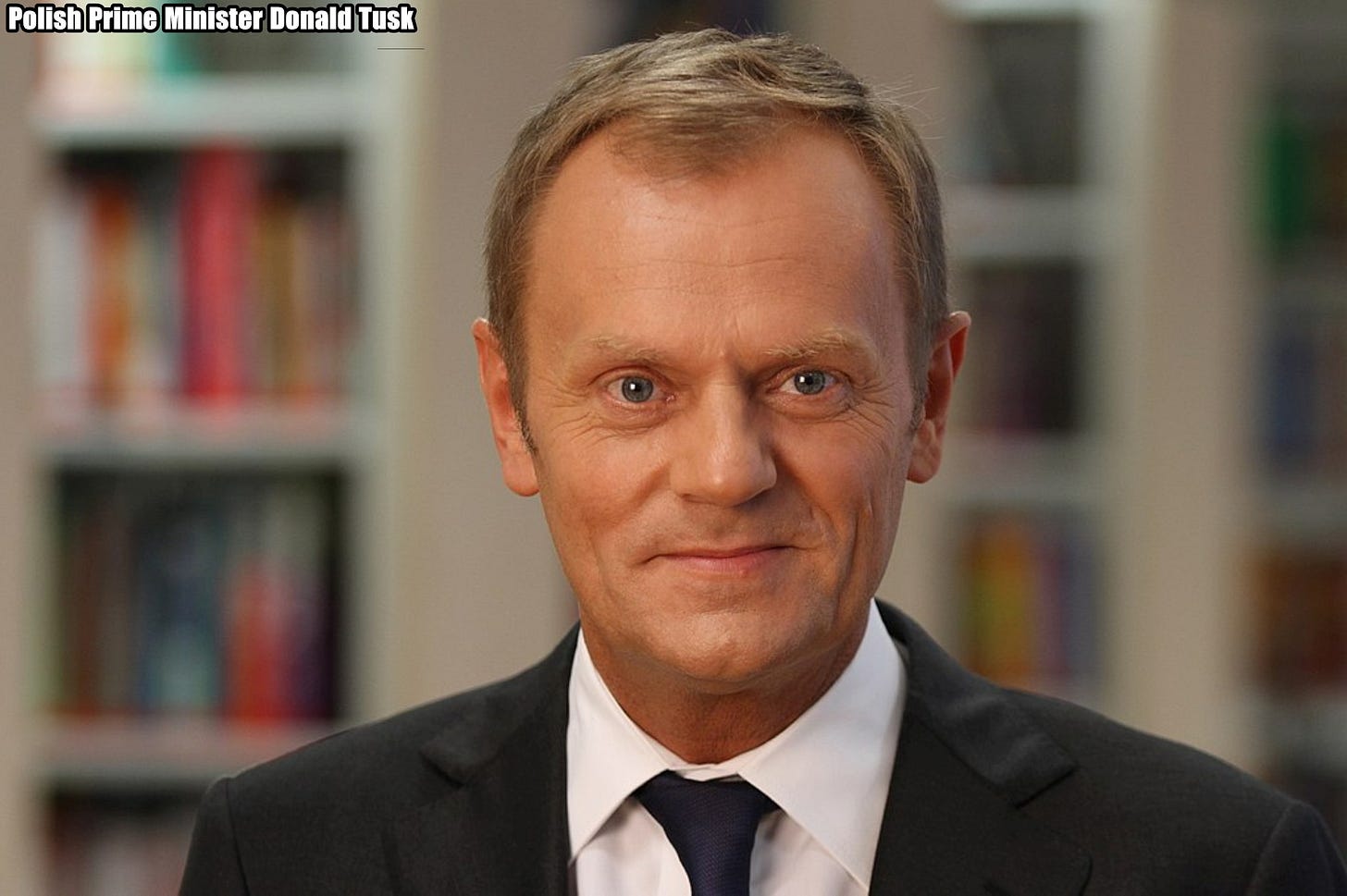Slava Ukraini! In early 2022 I began a Telegram channel aggregating news from a number of sources daily on the war in Ukraine. In June 2023 I began providing a daily draft for the Ukraine War Brief Podcast collecting news from over 70 sources daily, which formed the basis of the script. While the Podcast no longer exists I have continued to make this Brief available for my followers here on Substack for those who wish to keep up with the news from the war.
All the latest news on the Russo-Ukraine War 6 days per week
ALONG THE CONTACT LINE
GSAFU Morning Report
The General Staff of the Armed Forces of Ukraine in its Operational Information update at 08:00 on Feb 13 stated that day 1085 of the full-scale invasion of the Russian Federation against Ukraine had begun.
The situation on the line of combat remains tense in some sectors. Ukrainian defenders continue to actively counteract the Russian aggressor, causing them significant losses in personnel, equipment and technology. Exhausting the enemy along the entire front line and continuing to disrupt the plans of Russian occupiers to advance deeper into the territory of Ukraine.
During the past day, 116 combat engagements took place.
Over the past 24 hours, the enemy carried out 2 missile strikes, 88 air strikes, used 3,038 drones and fired approximately 5,800 artillery shells across the positions of Ukrainian forces and civilians.
Air Force Daily Report
85 ENEMY UAVS WERE SHOT DOWN, 52 DROIDS DID NOT REACH THEIR TARGETS (LOCATIONALLY LOST)
➖➖➖➖➖➖➖➖➖
On the night of February 13, 2025 (from 8:00 p.m. on February 12), the enemy attacked with 140 Shahed attack UAVs and simulator drones of various types from the directions: Orel, Kursk, Bryansk, Shatalovo, Primorsko-Akhtarsk - Russia.
The air attack was repelled by aviation, anti-aircraft missile troops, electronic warfare units, and mobile fire groups of the Air Force and Defense Forces of Ukraine.
As of 09:00, it has been confirmed that 85 Shahed attack UAVs and drones of other types have been shot down in Kharkiv, Poltava, Sumy, Cherkasy, Chernihiv, Kirovohrad, Dnipropetrovsk, Mykolaiv, Kherson and Odessa regions.
52 enemy drone simulators were lost in location (without negative consequences).
As a result of the enemy attack, the Odessa and Kharkiv regions suffered.
Combat Operations in the Kursk Sector, Russian Federation
The Institute for the Study of War (ISW), a US based think tank, in its Feb 12 Russian Offensive Campaign Assessment reported that Ukrainian and Russian forces recently advanced in Kursk Oblast. Russian milbloggers claimed that fighting continued northwest of Sudzha near Nikolskyi; east of Sudzha near Russkaya Konopelka; and southeast of Sudzha near Cherkasskaya Konopelka. Russian milbloggers claimed that Russian forces repelled five Ukrainian attacks near Kurilovka (south of Sudzha).
A Ukrainian brigade operating in Kursk Oblast posted footage on Feb 12 showing the brigade repelling a platoon-sized Russian mechanized assault in an unspecified area in Kursk Oblast.
Geolocated footage published on Feb 11 indicates that Ukrainian forces recently advanced northwest and northeast of Fanaseyevka (southeast of Sudzha) during a platoon-sized mechanized assault in the area.
Geolocated footage published on Feb 12 indicates that Russian forces advanced into western Sverdlikovo (west of Sudzha) on the west (right) bank of the Loknya River. Russian milbloggers claimed that elements of the 106th Airborne (VDV) Division advanced in Sverdlikovo.
The Khortytsia operational-strategic group
(Responsible for the northeastern part of Ukraine. )
Borova Sector: Russian forces continued ground attacks northeast of Borova near Zahryzove and Nova Kruhlyakivka; east of Borova near Zeleny Hai, Novoyehoriivka, and Kopanky; and southeast of Borova near Novoserhiivka and Novomykhailivka on February 11 and 12.]
A Ukrainian commander operating in the Borova direction reported on Feb 12 that Ukrainian forces repelled a Russian mechanized assault of an unspecified echelon in this direction.
Geolocated footage published on Feb 12 indicates that Russian forces recently advanced in southern Makiivka (southeast of Borova).
Siversk Sector: Russian forces recently advanced northeast of Siversk.
Geolocated footage published on Feb 12 indicates Russian forces recently advanced along Tsentralna street on the western outskirts of Bilohorivka (northeast of Siversk).
Toretsk Sector: Russian and Ukrainian forces recently advanced in Toretsk. Russian forces continued attacking near and within Toretsk; west of Toretsk near Shcherbynivka; and north of Toretsk near Dyliivka on Feb 11 and 12
Geolocated footage published on Feb 12 indicates that Ukrainian forces recently advanced in the Toretska Mine area (northern Toretsk).
Geolocated footage published on Feb 11 indicates that Russian forces recently advanced in northwestern Toretsk.
The Tavria operational-strategic group
(Responsible for the central-eastern and southeastern part of Ukraine.)
Pokrovsk Sector : Russian forces continued attacking east of Pokrovsk near Vodyane Druhe, Tarasivka, Yelyazvetivka, and Promin; southeast of Pokrovsk near Lysivka; south of Pokrovsk near Pishchane and Zvirove; and southwest of Pokrovsk near Kotlyne, Udachne, Molodetske, Nadiivka and Uspenivka.
Ukraine's Khortytsia Group of Forces published footage on Feb 12 showing Russian forces conducting at least a platoon-sized mechanized assault in the Pokrovsk direction. Russian milbloggers claimed that Ukrainian forces attacked the eastern outskirts of Vovkove (south of Pokrovsk and west of Pishchane), presumably from Pishchane, and that Ukrainian forces pushed Russian forces back to the outskirts of Kotlyne. Russian milbloggers claimed that Ukrainian forces continued counterattacking near Pishchane, Zvirove, and Vodyane Druhe.
Geolocated footage published on February 11 indicates that Russian forces recently advanced southwest of Vodyane Druhe and in eastern Pishchane.
Kurakhove Sector: Russian forces recently advanced in the Kurakhove direction. Russian forces continued offensive operations northwest of Kurakhove near Shevchenko and Andriivka and west of Kurakhove near Dachne, Kostyantynopil, Oleksiivka, and Bahatyr.
Geolocated footage published on Feb 12 indicates that Russian forces recently advanced southwest of Dachne.
The Odesa operational-strategic group
(Responsible for Kherson, Qırım, (also known as Crimea) and the Black Sea.)
There have been no major changes to the combat environment since our last report.
TEMPORARILY OCCUPIED TERRITORIES
Nothing major to report.
THE HOME FRONT
1 killed, 20 injured in Russian attacks across Ukraine over the past day.
Russian attacks on multiple Ukrainian regions killed at least one civilian and injured 20 over the past day, the Kyiv Independent reported citing regional authorities on Feb. 13.
Overnight, Russia launched 140 Shahed-type combat and decoy drones, the Ukrainian Air Force said. Ukrainian air defenses shot down 85 drones across 10 oblasts, while 52 others were lost without causing damage.
In Kherson Oblast, one person was killed, and 10 others were injured as Russian troops hit residential areas and social infrastructure, damaging two high-rise buildings and 12 private houses, according to governor Oleksandr Prokudin.
In Donetsk Oblast, four residents were wounded in attacks on Katerynivka, Komar, and Nikiforivka, Governor Vadym Filashkin said.
In Sumy Oblast, Russian forces attacked 13 communities, injuring five people and damaging residential buildings, a school, and farm structures, local military administration reported.
In Odesa Oblast, shrapnel from a Russian drone strike hit a car, injuring a woman who was hospitalized in moderate condition, Governor Oleh Kiper reported.
In Zaporizhzhia Oblast, the attacks resulted in 20 reports of damage to apartments and private houses, but no casualties, Governor Ivan Fedorov said.
In Dnipropetrovsk Oblast, a Russian attack damaged 10 private houses, two outbuildings, power lines, and a gas pipeline, but no casualties were reported, Governor Serhii Lysak said.
RUSSIAN WORLD
‘Doing Our Job For Us’: Russian State Media Rejoice at Trump’s Putin Embrace.
Russian state media, officials and prominent bloggers are celebrating the news that U.S. President Donald Trump would negotiate with President Vladimir Putin to end the war in Ukraine without pushing for Kyiv’s key peace demands to be met.The Moscow Times reports.
In a discussion on state broadcaster Rossia 1, Russian political scientist Sergei Luzyanin praised what he called the “three ‘No’s’” of U.S. Secretary of Defense Pete Hegseth: “‘No’ to American weapon deliveries to Ukraine, ‘No’ to Hegseth meeting with the Ukrainian delegation [at Friday’s Ramstein format meeting] and ‘No’ to the potential escalation of this war.”
Luzyanin said the main symbol of American foreign policy was Trump’s “insane, enormously long signature,” and that Trump was “sawing through the Western world.”
Host Yevgeny Popov quipped that Trump was doing Russia’s job for it. “We wanted to saw the Western world into pieces, but he decided to saw through it himself,” Popov said.
On Thursday morning, the state-run RIA Novosti news agency published an op-ed titled “The U.S. Has Finally Done Zelensky a Real Disservice.”
The piece’s author writes that the Trump administration’s announcements were “merciless” to Zelenskyy and that Trump was “not at all interested in the opinions of Kyiv and Brussels.”
“Trump expects from Zelenskyy the same thing he demands from all his appointees: less of his own opinion and more of a speedy execution of orders. That's his style, that's all Trump is, and he doesn't communicate with Russia in that style, most likely only because he's seen that it's not promising with Russia,” the op-ed reads.
A different RIA Novosti piece claims that European sentiment toward Ukrainian refugees has shifted dramatically and casts Ukrainian refugees as criminals who “will agree to any conditions as long as they do not return to their homeland.”
A third headline on the site reads “Zelenskyy Told Grim News After Talks Between Putin and Trump.” It quotes right-wing American social media influencer Jackson Hinkle, saying that Zelenskyy would be “informed of, BUT NOT INCLUDED IN, the U.S.-RUSSIA peace deal negotiations’.”
Another state-run news agency, TASS, released a roundup of news coverage from around the world with the title, “‘Fear and Trembling in Kyiv’: Global Media on the Telephone Conversation Between the Russian and U.S. Presidents.”
TASS also republished part of a Telegram post from Senator Konstantin Kosachev in which he criticized the Biden administration, Europe and NATO for being the “party of war.”
Kosachev characterized NATO Secretary General Mark Rutte’s willingness to start peace talks as “re-shoeing in the air” after NATO did “everything possible and impossible to inflict a strategic defeat on Russia.”
“It is known that there are no eternal allies, only eternal interests. Russia has learned to defend its interests, even when it is incredibly difficult and even when it seems impossible. Indeed, it is possible,” he continued.
The Kommersant business daily, which is not state-run, ran a roundup of international media coverage of the day’s events under the headline “Putin’s Day of Triumph.”
Media personality Ksenia Sobchak, the daughter of one of Putin’s early political allies and the president’s alleged goddaughter, wrote on her Telegram channel: “One hundred percent things will not go smoothly, that's clear. Just like the fact that no ‘territory swap’ will happen, Putin will never back down, especially publicly… But the dialogue has been started, and I am infinitely glad about it. May it end as soon as possible.”
The English-language propaganda outlets RT and Sputnik covered Trump’s comments extensively, with posts on X reading: “‘At some point you’re going to have elections too’: Trump on Zelensky”; “'I think we're on the way to peace with Russia and Ukraine' — Trump. He adds that he'll meet with Putin, 'probably in Saudi Arabia.' But he hasn't 'committed' to going to Ukraine”; and “NO PLACE FOR ZELENSKYY IN FIRST PUTIN-TRUMP MEETING – TRUMP. Trump added that he hasn’t committed to visiting Ukraine.”
INTERNATIONAL NEWS
Ukraine will not accept any negotiations without its participation - Zelenskyy
President Volodymyr Zelenskyy emphasized that Ukraine would not agree to any peace talks without its direct participation. The head of state said this during a visit to the Khmelnytskyi NPP, Censor.NET reports.
"I make this very clear to our partners: any bilateral talks about Ukraine—I'm not talking about other topics, they are free to discuss those—any bilateral talks about Ukraine without us will not be accepted," Zelenskyy said.
According to him, negotiations should first take place in the Ukraine-US format, and only after a concrete plan to end the war is developed can we talk about the possibility of contacts with Russia.
Speaking about his recent phone conversation with Donald Trump, Zelenskyy said that it was "really good, almost an hour long." Trump suggested that Putin seems to want peace, but the Ukrainian leader was skeptical of this statement.
In addition, Zelenskyy emphasized the importance of European countries' participation in the negotiations, as they are part of the war just like Ukraine. According to him, 80% of the costs of the war are currently borne by Ukraine together with Europe, while the US contribution is 20%.
"The main thing today is that everything does not go according to Putin's plan. He wants to have bilateral negotiations with the United States," Zelenskyy emphasized.
Kyiv, EU alarmed by prospect of 'dirty deal' after Trump-Putin call.
Kyiv and its European allies demanded on Thursday that they be included in any peace negotiations, after U.S. President Donald Trump spoke by phone with Russia's Vladimir Putin and said Ukraine could neither have all of its land back nor join NATO. Reuters reported on Feb 13.
Russia's financial markets soared and the price of Ukraine's debt rose at the prospect of the first peace talks since the early months of Europe's deadliest war since World War Two, soon to enter its fourth year.
But Trump's unilateral overture to Putin, accompanied by apparent concessions on Ukraine's principal demands, raised alarm for both Kyiv and the European allies in NATO who said they feared the White House might make a deal without them.
"We, as a sovereign country, simply will not be able to accept any agreements without us," Ukrainian President Volodymyr Zelenskyy said.
He said Putin aimed to make his negotiations bilateral with the United States, and it was important not to allow that.
European officials took an exceptionally firm line in public towards Trump's peace overture, saying any agreement would be impossible to implement unless they and the Ukrainians were included in negotiating it. (see below)
Trump, who made the first publicly acknowledged White House call with Putin since the February 2022 full-scale invasion, and then followed it up with a call to Zelenskyy, said he believed both men wanted peace.
But the Trump administration also said openly for the first time that it was unrealistic for Ukraine to expect to return to its 2014 borders or join the NATO alliance as part of any agreement, and that no U.S. troops would join any security force in Ukraine that might be set up to guarantee a ceasefire.
U.S. Defense Secretary Pete Hegseth said on Thursday the world was fortunate to have Trump, the "best negotiator on the planet, bringing two sides together to find a negotiated peace".
The Kremlin, for its part, said it was "impressed" by Trump's position, which it contrasted with that of his predecessor Joe Biden.
"There is a political will, which was emphasised during yesterday's conversation, to conduct a dialogue in search of a settlement," Kremlin spokesman Dmitry Peskov said.
Russia seized Ukraine's Crimea peninsula and its proxies captured territory in the east in 2014, before its full-scale invasion in 2022 when it captured more land in the east and south.
Ukraine pushed Russian troops back from the outskirts of Kyiv and recaptured swathes of territory in 2022, but its outmanned and outgunned forces have slowly ceded more land since a failed Ukrainian counter-offensive in 2023.
Relentless fighting has killed or injured hundreds of thousands of troops on both sides - there is no reliable death toll - and pulverised Ukrainian cities.
Through years of fighting there has been no narrowing of positions on either side. Moscow demands Kyiv cede more land and be rendered permanently neutral in any peace deal; Kyiv says Russian troops must withdraw and it must win security guarantees equivalent to NATO membership to prevent future attacks.
Ukrainian officials have acknowledged in the past that full NATO membership may be out of reach in the short term and that a hypothetical peace deal could leave some occupied land in Russian hands.
But Kyiv and its European allies made clear they were alarmed by Trump having opened negotiations with apparent concessions to Moscow, without first agreeing a common position.
Ukraine's Foreign Minister Andrii Sybiha said Kyiv remained committed to applying to join NATO, which he said was the simplest and least expensive way the West could provide the security guarantees needed to ensure peace.
"All our allies have said the path of Ukraine towards NATO is irreversible. This prospect is in our constitution. It is in our strategic interest."
The mood in Ukraine's capital on Thursday was downbeat.
Kyiv resident Myroslava Lesko, 23, standing near a sea of flags downtown honouring fallen troops, said: "It truly looks as if they want to surrender Ukraine, because I don't see any benefits for our country from these negotiations or Trump's rhetoric."
However, Ukrainians have been worn out by three years of war, and many say they are prepared to sacrifice some aims to achieve peace.
Many were frustrated by U.S. policy under former President Biden, who had vowed to help Ukraine win all its land back and provided tens of billions of dollars worth of military hardware, but with restrictions and delays that Ukrainian commanders say allowed Russian forces to regroup.
Trump, at least, is being more forthright about the limits of U.S. support, said Tymofiy Mylovanov, president of the Kyiv School of Economics.
"The difference between Biden and Trump is that Trump says out loud what Biden was thinking and doing about Ukraine," he said.
Europeans warn US against Ukraine deal 'behind our backs'
European leaders warned the United States on Thursday against sealing a Ukraine peace deal with Russia behind their backs as they scrambled for a seat at the table after Donald Trump spoke to Vladimir Putin and announced the start of negotiations.
U.S. President Trump's move sent shockwaves through European capitals, which want a central role in peace talks because any settlement in Ukraine, hit by a full-scale Russian invasion three years ago, will have ramifications for their own security.
"It is clear that any deal behind our backs will not work. Any agreement will need also Ukraine and Europe being part of it," European Union foreign policy chief Kaja Kallas said.
"Why are we giving them (Russia) everything that they want even before the negotiations have been started?" said Kallas, speaking before a meeting of NATO defence ministers with their Ukrainian counterpart in Brussels.
"It's appeasement. It has never worked."
German Defence Minister Boris Pistorius also said it would have been better if Washington had not given what he called concessions to Moscow before peace talks even started.
Kallas said any agreement without European and Ukrainian participation would fail and Europe would continue to support Kyiv if it resisted a settlement that was imposed upon it.
"Any quick fix is a dirty deal," said Kallas.
French Defence Minister Sebastien Lecornu warned against "peace through weakness" rather than the Trump officials' mantra of "peace through strength".
Lithuanian Defence Minister Dovile Sakaliene said Europe should not fall "under the illusion that Mr. Trump and Mr. Putin are going to find the solution for all of us".
Defending the U.S. approach, Hegseth said the world was fortunate to have Trump, the "best negotiator on the planet, bringing two sides together to find a negotiated peace".
Many European officials had hoped that a series of meetings with officials in Brussels and Munich this week would be their opportunity to influence U.S. thinking on the war.
But it soon became clear that the Trump administration was moving ahead without them.
Hours after Hegseth spoke, Trump said he had held a "highly productive phone call" with Russia's Putin and they had agreed to start negotiations immediately. He then briefed Ukrainian President Volodymyr Zelenskyy on the call.
In a late-night statement after talks in Paris on Wednesday, foreign ministers from European powers - including Britain, France and Germany - said Europe must be part of any future negotiations on Ukraine.
A European diplomatic source said the ministers agreed to engage in a "frank and demanding dialogue" with U.S. officials at the annual Munich Security Conference - a three-day gathering that starts in the southern German city this Friday.
Not all European leaders were alarmed by Trump's move.
Hungarian Prime Minister Viktor Orban, a Trump ally, praised the U.S. president and criticised the ministers' statement.
"You can't request a seat at the negotiating table. You have to earn it!" he said on social media.
European leaders say one reason they need to be involved in talks is that Washington has made clear it expects them to provide security guarantees for any peace deal, which could mean European troops being deployed to Ukraine.
"There is no option to not be at the table, because we are very important in the actual implementation of those security guarantees," said Dutch Defence Minister Ruben Brekelmans.
Tusk called on political forces and leaders to stop debating war and peace in Ukraine.
Polish Prime Minister Donald Tusk has called on all political forces and leaders to stop arguing about war and peace in Ukraine and to be united in the face of threats from the East. Censor.net reports citing a post from Tusk on social media.
"The international situation is so serious that we cannot afford to argue about our security at home. I call on all political forces and leaders to stop arguing about war and peace in Ukraine and to be united in the face of the threat from the East. Poland, Europe and the entire West need full cooperation and solidarity today," he said in the post.
MILITARY & TECH
British Gravehawk SAM system, Designed Specially for Ukraine, Doesn’t Look Like Everyone Expected.
Supplies by the United Kingdom of a classified anti-aircraft missile system to Ukraine was disclosed to the public in 2024. This year, on January 16, British Prime Minister Keir Starmer revealed the name of this secret weapon: Gravehawk, adding that 15 of them will be delivered, with two prototypes already protecting Ukrainian skies. Defense Express reports.
The Gravehawk air defense system was implemented right in a standard shipping container and it fires Ukrainian R-73 air-to-air missiles
All these details matched the description of an air defense system that was known to be covertly supplied beforehand and only a few times appeared in frontline videos on social media, namely the mysterious mobile launcher for AIM-132 ASRAAM missiles mounted on a Supacat HMT truck. Linking the two together, many assumed Gravehawk was its official name.
However, as it turns out, those two are actually completely different missile systems, and when Keir Starmer said that Gravehawk fits into a single sea shipping container and uses Ukrainian missiles, he meant exactly that. As shown in a video obtained by BFBS Forces News from the UK Ministry of Defense, Gravehawk is literally made in the form of an intermodal freight container and uses Ukrainian-made R-73 missiles.
According to the report, Gravehawk is a short-range system because the R-73, when launched from the ground, can intercept threats within an estimated range of 12 km, at altitudes up to several kilometers. This is enough to defeat such threats as cruise missiles and drones or deploy a local air cover for a particular potential target.
The R-73 missiles are placed on standard pylons under a sliding roof. The launcher accommodates two missiles and perhaps can extend outward from the container because otherwise the infrared homing guidance and launch of missiles becomes limited to a very narrow sector.
The R-73s were integrated into a new fire control system that uses an electro-optical targeting system. Most likely, it includes both optical and thermal imaging channels and a laser rangefinder to determine the distance to the target.
A separate photo in the article shows the control panel for the said EOTS, which allows the system operator to track and lock on targets and fire missiles. The controller is similar to a regular gamepad for a gaming console.
That’s it for today’s Brief folks if you would like to keep up with events in Ukraine daily please consider subscribing, it’s free!


